Distribution and Habitat Selection of Free-Ranging European Bison (Bison bonasus L.) in a Mosaic Landscape—A Lithuanian Case
Abstract
1. Introduction
2. Materials and Methods
2.1. Study Area
2.2. Data Sampling
2.3. Data Analyses
3. Results
3.1. Distribution of and Damage by Free-Ranging European Bison
3.2. Habitat Selection by Free-Ranging European Bison
4. Discussion
5. Conclusions
Author Contributions
Funding
Acknowledgments
Conflicts of Interest
References
- Pucek, Z.; Belousova, I.P.; Krasińska, M.; Krasiński, Z.A.; Olech, W. European Bison. Status Survey and Conservation Action Plan; IUCN/SSC Bison Specialist Group; IUCN: Gland, Switzerland, 2004; p. 54. ISBN 2-8317-0762-5. [Google Scholar]
- Krasinski, Z.A. Dynamics and structure of the European bison in the Bialowieza Primeval Forest. Acta Theriol. 1978, 23, 13–48. [Google Scholar] [CrossRef]
- Perzanowski, K.; Olech, W.; Kozak, H. Constraints for re-establishing a meta-population of the European bison in Ukraine. Biol. Conserv. 2004, 120, 345–353. [Google Scholar] [CrossRef]
- Decker, S.E.; Bath, A.J.; Simms, A.; Lindner, U.; Reisinger, E. The Return of the King or Bringing Snails to the Garden? The Human Dimensions of a Proposed Restoration of European Bison (Bison bonasus) in Germany. Res. Ecol. 2010, 18, 41–51. [Google Scholar] [CrossRef]
- Mysterud, A.; Barton, K.A.; Jędrzejewska, B.; Krasinski, Z.A.; Niedzialkowska, M.; Kamler, J.F.; Yoccoz, N.G.; Stenseth, N.C. Population ecology and conservation of endangered megafauna: The case of European bison in Bialowieza Primeval Forest, Poland. Anim. Concerv. 2007, 10, 77–87. [Google Scholar] [CrossRef]
- Matson, P.A.; Parton, W.J.; Power, A.G.; Swift, M.J. Agricultural intensification and ecosystem properties. Science 1997, 277, 504–509. [Google Scholar] [CrossRef]
- Balčiauskas, L. European bison (Bison bonasus) in Lithuania: Status and possibilities of range extension. Acta Zool. Litu. 1999, 3, 3–18. [Google Scholar] [CrossRef]
- Gordon, J.I. What is the future of wild, large herbivores in human-modified agricultural landscapes? Wildl. Biol. 2009, 15, 1–9. [Google Scholar] [CrossRef]
- Kerley, G.I.H.; Kowalczyk, R.; Cromsigt, J.P.G.M. Conservation implications of the refugee species concept and the European bison: King of the forest or refugee in a marginal habitat? Ecography 2012, 35, 519–529. [Google Scholar] [CrossRef]
- Hofman-Kaminska, E.; Kowalczyl, R. Farm Crops Depredation by European Bison (Bison bonasus) in the Vicinity of Forest Habitats in Northeastern Poland. Environ. Manag. 2012, 50, 530–541. [Google Scholar] [CrossRef] [PubMed]
- Gill, R.M.A. A review of damage by mammals in north temperate forests: 3. Impact on trees and forests. Forestry 1992, 65, 363–388. [Google Scholar] [CrossRef]
- Marozas, V.; Pėtelis, K.; Brazaitis, G.; Baranauskaitė, J. Early Changes of Ground Vegetation in Fallow Deer Enclosure. Balt. For. 2009, 15, 268–272. [Google Scholar]
- Belova, O. The impact of herbivorous mammals on woody vegetation in the different stages of forest succession. Balt. For. 2012, 18, 100–110. [Google Scholar]
- Brazaitis, G.; Pėtelis, K.; Žalkauskas, R.; Belova, O.; Danusevičius, D.; Marozas, V.; Narauskaitė, G. Landscape effect for the Cervidaes Cervidae in human-dominated fragmented forests. Eur. J. For. Res. 2014, 133, 857–869. [Google Scholar] [CrossRef]
- Goswami, V.R.; Medhi, K.; Nichols, J.D.; Oli, M.K. Mechanistic understanding of human–wildlife conflict through a novel application of dynamic occupancy models. Conserv. Biol. 2015, 29, 1100–1110. [Google Scholar] [CrossRef]
- van de Vlasakker, J. Rewilding Europe Bison Rewilding Plan 2014–2024; Rewilding Europe: Nijmegen, The Netherlands, 2014; p. 68. ISBN 978-90-822514-0-1. [Google Scholar]
- European Bison (Bison bonasus L.) Protection Plan. Available online: https://e-seimas.lrs.lt/portal/legalAct/lt/TAD/b3f90932605411e5b316b7e07d98304b/sMcpebTRCw (accessed on 5 April 2019). (In Lithuanian).
- Červený, J.; Ježek, M.; Holá, M.; Zikmund, M.; Kušta, T.; Hanzal, V.; Kropil, R. Daily activity rhythm and habitat use of the semi-free European bison herd during the growing season. For. J. 2014, 60, 199–204. [Google Scholar] [CrossRef][Green Version]
- Kibiša, A.; Marozas, V.; Talijūnas, D.; Papšys, R.; Sabalinkienė, G.; Šimkevičius, K. Impact of Free-Ranging European Bison to Ecosystems in Fragmented Landscape, Lithuania. Balk. J. Wildl. Res. 2017, 4, 18–25. [Google Scholar] [CrossRef][Green Version]
- Balčiauskas, L.; Kazlauskas, M. Forty years after reintroduction in a suboptimal landscape: Public attitudes towards European bison. Eur. J. Wildl. Res. 2014, 60, 155–158. [Google Scholar] [CrossRef]
- Krasińska, M.; Caboń-Raczyńska, K.; Krasiński, Z.A. Strategy of habitat utilisation by European bison in the Białowieża Forest. Acta Theriol. 1987, 32, 147–202. [Google Scholar] [CrossRef]
- Krasińska, M.; Krasiński, Z.A.; Bunevich, A.N. Factors affecting the variability in home range size and distribution in the Polish and Belarussian parts of the Białowieża Forest. Acta Theriol. 2000, 45, 321–334. [Google Scholar] [CrossRef]
- Boitani, L.; Fuller, T. Research Techniques in Animal Ecology; Columbia University Press: New York, NY, USA, 2000; p. 464. ISBN 978-0231113410. [Google Scholar]
- Jacobs, J. Quantitative measurement of food selection. Oecologia 1974, 14, 413–417. [Google Scholar] [CrossRef] [PubMed]
- Mendoza, M.; Palmqvist, P. Hypsodonty in ungulates: An adaptation for grass consumption or for foraging in open habitat? J. Zool. 2008, 274, 134–142. [Google Scholar] [CrossRef]
- Daleszczyk, K.; Krasińska, M.; Krasiński, Z.A.; Bunevich, A.N. Habitat structure, climatic factors, and habitat use by European bison (Bison bonasus) in Polish and Belarusian parts of the Bialowieza Forest, Poland. Can. J. Zool. 2007, 85, 26–272. [Google Scholar] [CrossRef]
- Kowalczyk, R. European bison–king of the forest, or meadows and river valleys? In European Bison Conservation in the Białowieża Forest Threats and Prospects of the Population Development, 2nd ed.; Kowalczyk, R., Lawreszuk, D., Wójcik, J.M., Eds.; Mammal Research Institute, Polish Academy of Sciences: Białowieża, Poland, 2010; pp. 123–134. ISBN 13 978-3642365546. [Google Scholar]
- Verkaar, E.L.C.; Beeke, M.; Hanekamp, E.; Nijman, I.J.; Lenstra, J.A. Maternal and paternal lineages in interbreeding bovine species. Is wisent a hybrid species? Mol. Biol. Evol. 2004, 21, 1165–1170. [Google Scholar] [CrossRef] [PubMed]
- Krasinska, M.; Krasinski, Z.A. European Bison, a Nature Monograph; Mammal Research institute, Polish Academy of Science: Bialowieza, Poland, 2007; p. 221. ISBN 978-83-907521-8-1. [Google Scholar]
- Denny, C.K.; Stenhouse, G.B.; Nielsen, S.E. Scales of selection and perception: Landscape heterogeneity of an important food resource influences habitat use by a large omnivore. Wildl. Biol. 2018, 2018. [Google Scholar] [CrossRef]
- Van Soest, P.J. Nutritional Ecology of the Ruminant, 2nd ed.; Cornell University Press: Ithaca, NY, USA, 1994; p. 488. ISBN 080142772X. [Google Scholar]
- Kowalczyk, R.; Krasińska, M.; Kamiński, T.; Górny, M.; Struś, P.; Hofman-Kamińska, E.; Krasiński, Z.A. Movements of European bison (Bison bonasus) beyond the Białowieza Forest (NE Poland): Range expansion or partial migrations? Acta Theriol. 2013, 58, 391–401. [Google Scholar] [CrossRef]
- Marchand, P.; Garel, M.; Bourgoin, G.; Dubray, D.; Maillard, D.; Loison, A. Coupling scale-specific habitat selection and activity reveals sex-specific food/cover trade-offs in a large herbivore. Anim. Behav. 2015, 102, 169–187. [Google Scholar] [CrossRef]
- Drucker, D.G.; Bocherens, H. Carbon stable isotopes of mammal bones as tracers of canopy development and habitat use in temperate and boreal contexts. In Forest Canopies: Forest Production, Ecosystem Health and Climate Conditions; Creighton, J.D., Roney, P.J., Eds.; Nova Science Publishers: Hauppauge, NY, USA, 2009; pp. 103–109. ISBN 978-1-60741-457-5. [Google Scholar]
- Dzięciołowski, R.M. Ecological niches of five big ungulates in Forest Tract. Folia Forestalia Polonica Ser. A For. 1991, 33, 56–70. [Google Scholar]
- Krasiński, Z.A.; Krasińska, M. Free ranging European bison in Borecka Forest. Acta Theriol. 1992, 37, 301–317. [Google Scholar] [CrossRef]
- Kuemmerle, T.; Radeloff, V.C.; Perzanowski, K.; Kozlo, P.; Sipko, T.; Khoyetskyy, P.; Bashta, A.T.; Chikurova, E.; Parnikoxa, I.; Baskin, L.; et al. Predicting potential European bison habitat across its former range. Ecol. Appl. 2011, 21, 830–843. [Google Scholar] [CrossRef] [PubMed]
- Krasiński, Z.A.; Krasińska, M.; Leniec, H. The European bison in the Knyszyn Forest. Parki. Nar. Rez. Przyr. 1994, 13, 107–114, (In Polish with English Summary). [Google Scholar]
- Brandtberg, N.H.; Dabelsteen, T. Habitat selection of two European bison (Bison bonasus) on the Danish island Bornholm. Eur. Bison Conserv. Newsl. 2013, 6, 73–80. [Google Scholar]
- Krasińska, M.; Krasiński, Z.A. Composition, group size and spatial distribution of European bison bulls in Białowieża Forest. Acta Theriol. 1995, 40, 1–21. [Google Scholar] [CrossRef]
- Korochkina, L.N.; Bunevich, A.N. Znachenie kormovykh polei v pitanii kopytnykh Belovezhskoi Pushchi. Zapovedniki Belarussi. Issledovaniya 1980, 4, 109–116. [Google Scholar]
- Kazmin, V.D.; Smirnov, K.A. Zimnee pitanie, kormovye resursy i troficheskoe vozdeistvie zubra na lesnye fitocenozy Tsentral’nogo Kavkaza. Byulleten’ Moskovskogo Obshchestva Ispytatelei Prirody Otdel Biologicheskii 1992, 97, 26–35. [Google Scholar]
- Balčiauskas, L.; Kazlauskas, M.; Balčiauskienė, L. European bison: Changes in species acceptance following plans for translocation. Eur. J. Wildl. Res. 2017, 63, 4. [Google Scholar] [CrossRef]
- Padaiga, V. Biological Fundamentals of the Game Management; Ziburys: Vilnius, Lithuania, 1996; 212p, ISBN 9986524091. (In Lithuanian with English Abstract). [Google Scholar]

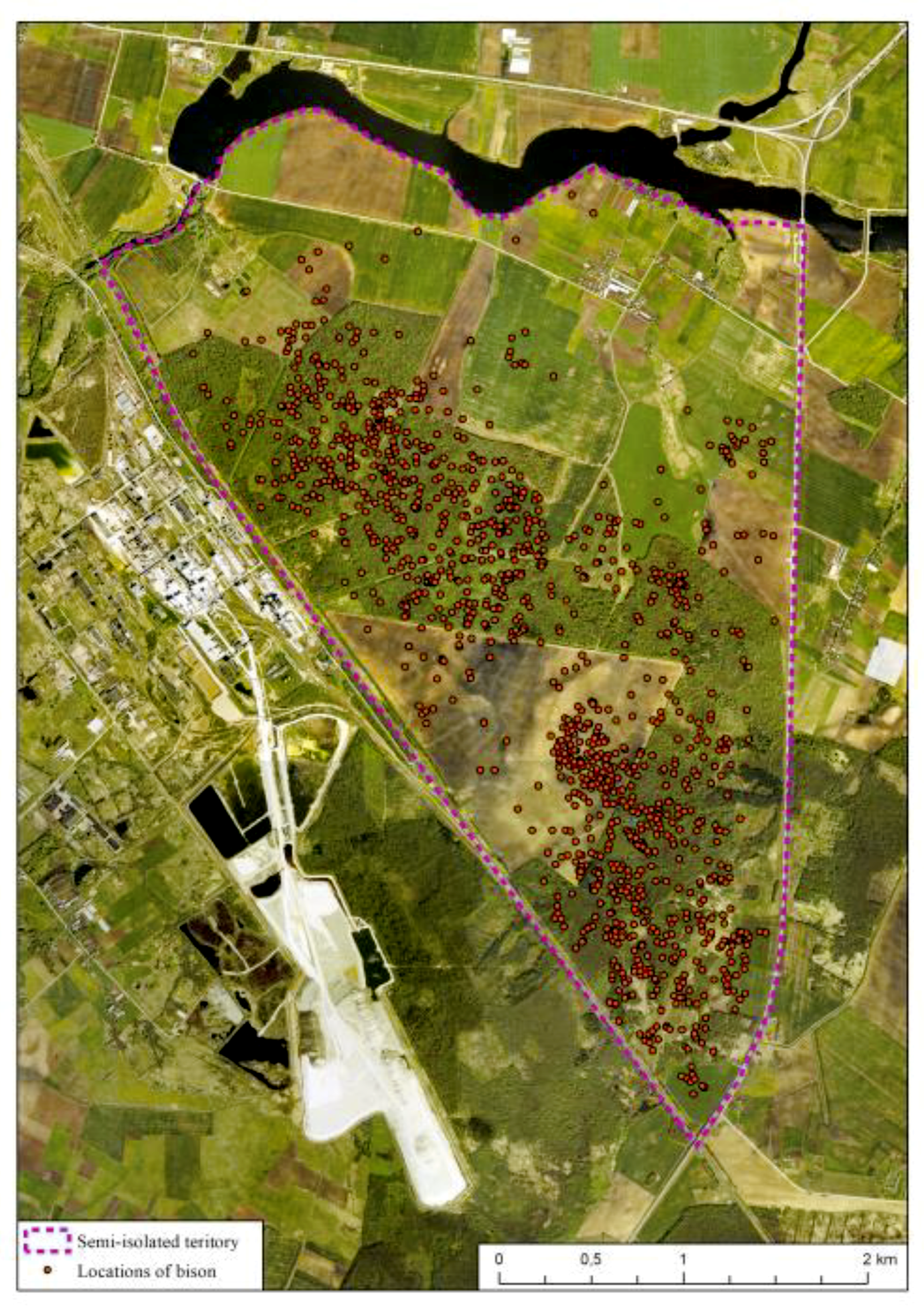
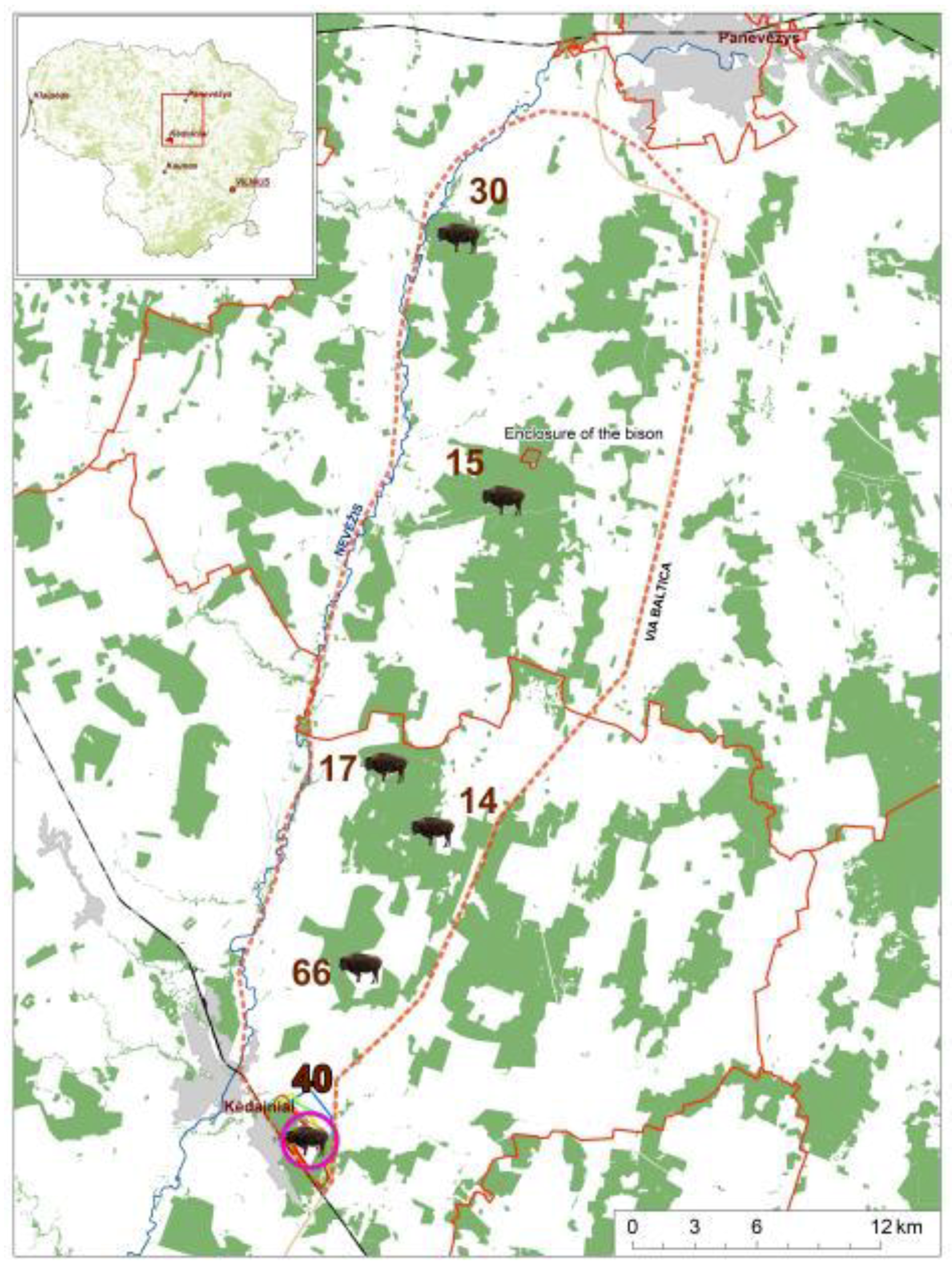
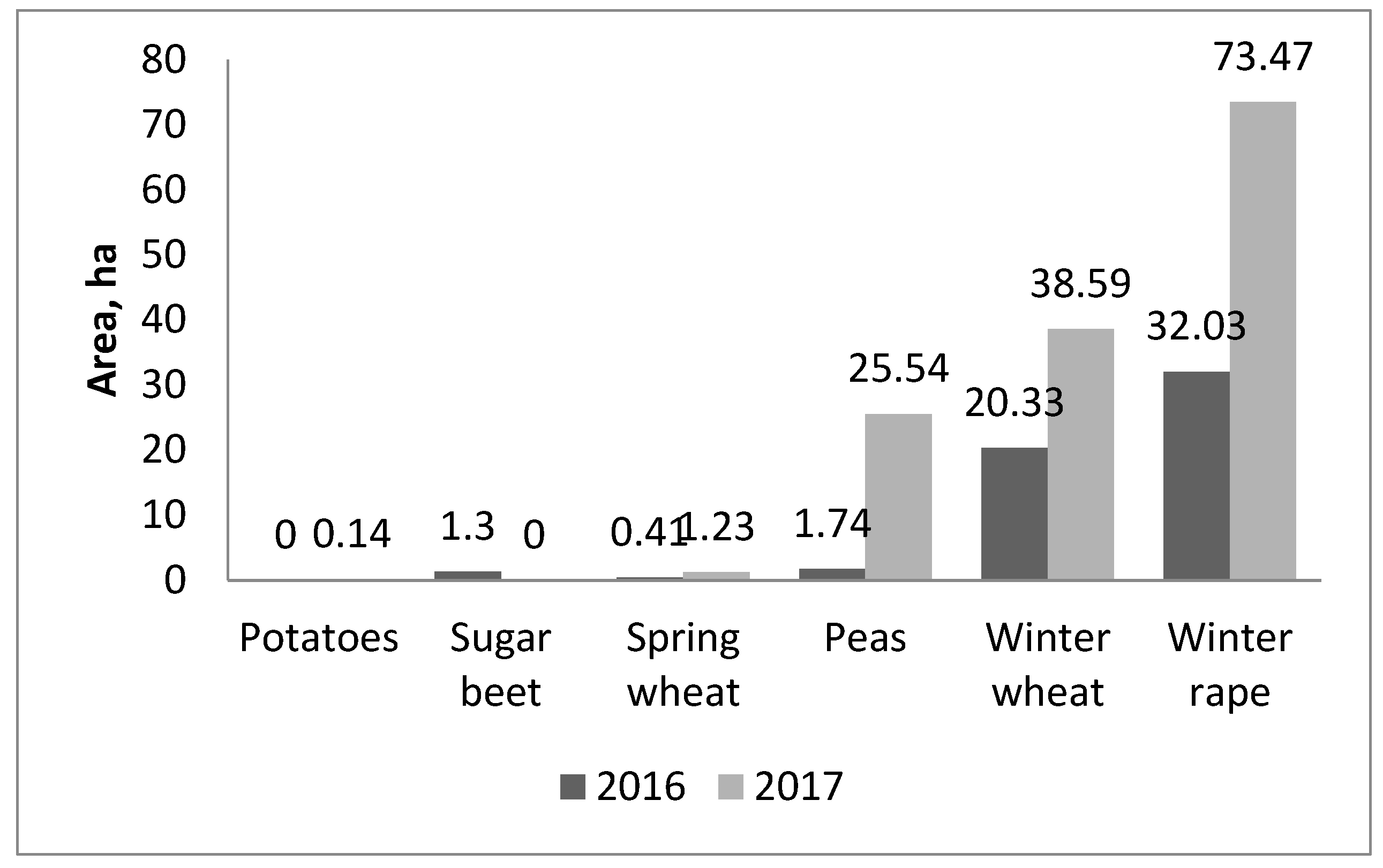
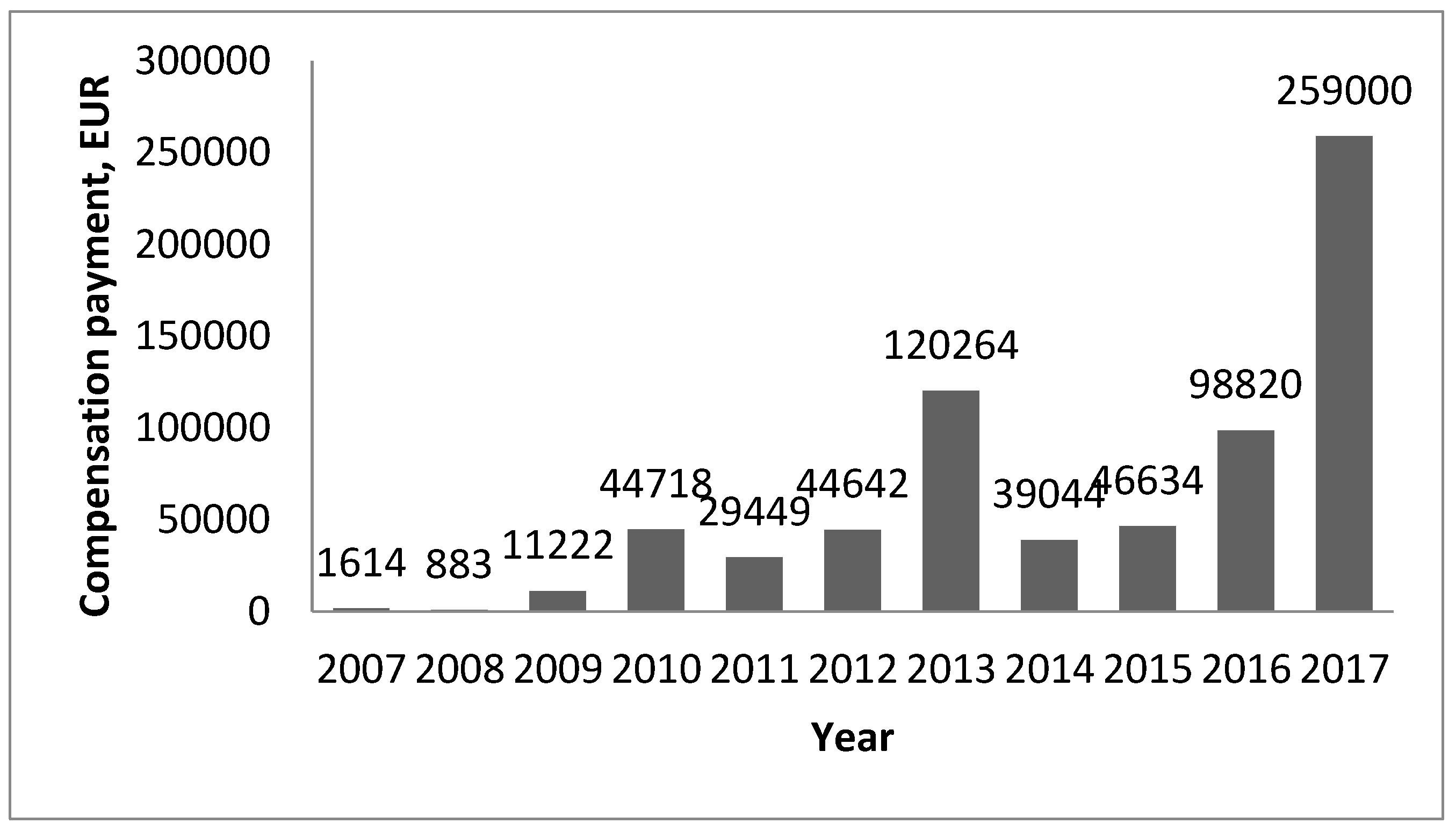
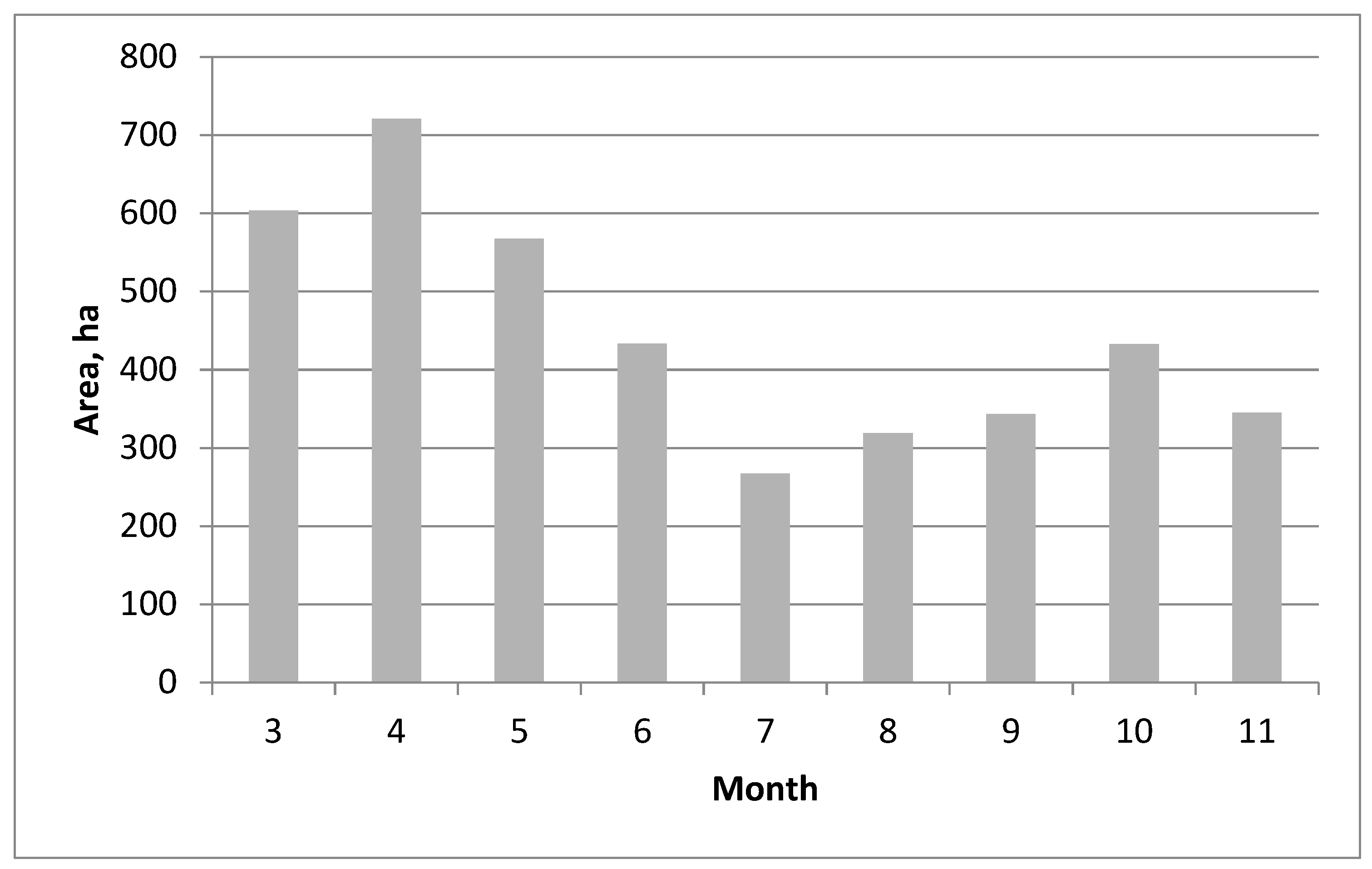
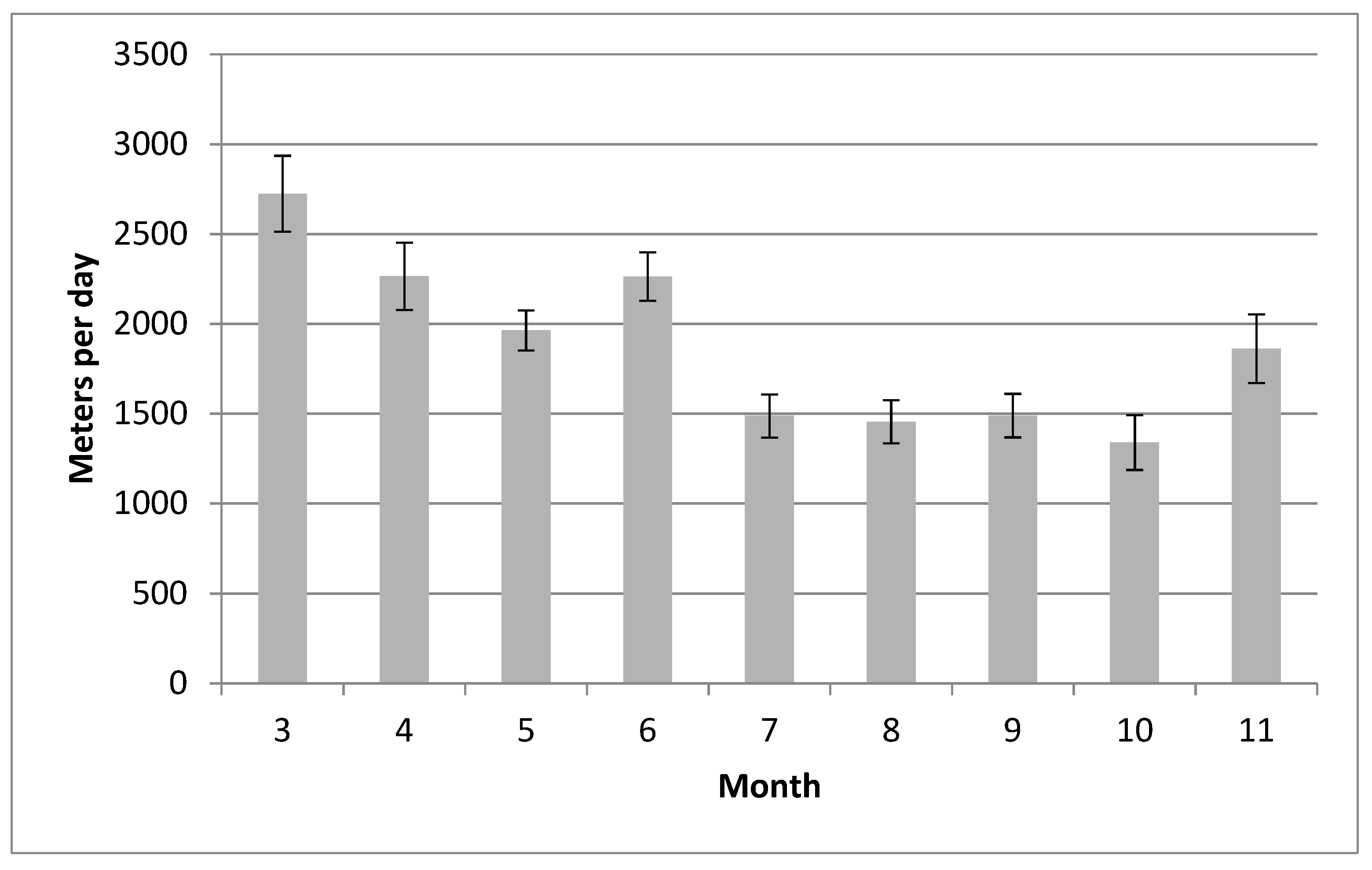

| Habitat Type | Habitat Proportion | Habitat Selection | Jacobs’ Index | Chi-Square | p |
|---|---|---|---|---|---|
| Agricultural land | 63 | 39 | −0.457 | 24.212 | <0.001 |
| Forest | 37 | 61 | 0.457 | ||
| Agricultural land day | 63 | 29 | −0.616 | 56.144 | <0.001 |
| Forest day | 37 | 71 | 0.616 | ||
| Agricultural land night | 63 | 56 | −0.145 | 1.989 | 0.158 |
| Forest night | 37 | 44 | 0.145 |
| Habitat Type | Habitat Proportion | Habitat Selection | Jacobs’ Index | Chi-Square | p |
|---|---|---|---|---|---|
| Cereal | 59 | 64 | 0.118 | 7.872 | 0.045 |
| Corn | 20 | 22 | 0.089 | ||
| Grasses | 14 | 7 | –0.411 | ||
| Abandoned land | 7 | 7 | 0.003 |
| Habitat Type | Habitat Proportion | Habitat Selection | Jacobs’ Index | Chi-Square | p |
|---|---|---|---|---|---|
| Clear-cut | 3 | 8 | 0.513 | 16.991 | <0.001 |
| Coniferous | 8 | 5 | –0.251 | ||
| Broad-leaved | 22 | 11 | –0.393 | ||
| Small-leaved | 67 | 76 | 0.223 | ||
| Ash | 21 | 11 | –0.356 | 16.755 | 0.002 |
| Birch | 27 | 19 | –0.230 | ||
| Black alder | 20 | 22 | 0.050 | ||
| Grey alder | 12 | 23 | 0.356 | ||
| Aspen | 6 | 9 | 0.215 |
| Habitat Type | Habitat Proportion | Habitat Selection | Jacobs’ Index | Chi-Square | p |
|---|---|---|---|---|---|
| Clear cuts | 3 | 8 | 0.513 | 65.097 | <0.001 |
| 10–20 | 12 | 8 | –0.213 | ||
| 30–40 | 12 | 26 | 0.429 | ||
| 50–60 | 18 | 10 | –0.303 | ||
| 70–80 | 33 | 11 | –0.608 | ||
| 90–100 | 18 | 25 | 0.229 | ||
| >100 | 4 | 12 | 0.485 |
| Habitat Type | Habitat Proportion | Habitat Selection | Jacobs’ Index | Chi-Square | p |
|---|---|---|---|---|---|
| Dry | 6 | 8 | 0.126 | 2.315 | 0.510 |
| Moist | 65 | 69 | 0.082 | ||
| Wet | 25 | 20 | –0.124 | ||
| Peat | 4 | 3 | –0.081 |
© 2019 by the authors. Licensee MDPI, Basel, Switzerland. This article is an open access article distributed under the terms and conditions of the Creative Commons Attribution (CC BY) license (http://creativecommons.org/licenses/by/4.0/).
Share and Cite
Marozas, V.; Kibiša, A.; Brazaitis, G.; Jõgiste, K.; Šimkevičius, K.; Bartkevičius, E. Distribution and Habitat Selection of Free-Ranging European Bison (Bison bonasus L.) in a Mosaic Landscape—A Lithuanian Case. Forests 2019, 10, 345. https://doi.org/10.3390/f10040345
Marozas V, Kibiša A, Brazaitis G, Jõgiste K, Šimkevičius K, Bartkevičius E. Distribution and Habitat Selection of Free-Ranging European Bison (Bison bonasus L.) in a Mosaic Landscape—A Lithuanian Case. Forests. 2019; 10(4):345. https://doi.org/10.3390/f10040345
Chicago/Turabian StyleMarozas, Vitas, Artūras Kibiša, Gediminas Brazaitis, Kalev Jõgiste, Kastytis Šimkevičius, and Edmundas Bartkevičius. 2019. "Distribution and Habitat Selection of Free-Ranging European Bison (Bison bonasus L.) in a Mosaic Landscape—A Lithuanian Case" Forests 10, no. 4: 345. https://doi.org/10.3390/f10040345
APA StyleMarozas, V., Kibiša, A., Brazaitis, G., Jõgiste, K., Šimkevičius, K., & Bartkevičius, E. (2019). Distribution and Habitat Selection of Free-Ranging European Bison (Bison bonasus L.) in a Mosaic Landscape—A Lithuanian Case. Forests, 10(4), 345. https://doi.org/10.3390/f10040345





